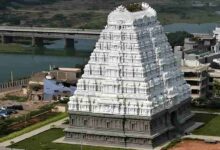Katasraj Temple: Where the sacred lake burst forth from Shiva’s tears, faith is still immortal on the land of Pakistan
Katasraj Temple: While Pakistan is home to numerous Hindu temples, Katasraj holds significant significance in mythology. Located at Katas, about 40 kilometers from Chakwal village in Pakistan, this temple is situated on a hill. Near the temple is a sacred pond where people bathe. Thousands of devotees visit this temple every year to visit Mahadev. In December, a group of Hindus from India also visited Katasraj.

Mythological Beliefs Related to Katasraj Temple
According to mythology, Lord Shiva was deeply saddened when his wife, Sati, the daughter of Daksha, committed suicide during a yagna (fire sacrifice). She died at that time. Lord Shiva then came to this place and mourned in Sati’s memory. It is believed that these tears formed two ponds. One is located here and is known as Kataksha Kund. The location of the other pond is said to be near Pushkar, Rajasthan. The word Katasraj has an interesting history. Daksha mocked Lord Shiva and his daughter Sati. This is why the place was named Katas. The architecture of both these temples is very ancient. It is believed that the Pandavas built seven temples here.
The Mahabharata period is also linked to this story
The history of the Katasraj temple is also linked to the Mahabharata period. It is said that after losing a game of dice for the first time, the Pandavas agreed to hide for a year and then undergo a 12-year exile. During this period, they stayed here for four years. The Nemkot mountain range is home to this temple. It is said that Lord Krishna inspired the construction of this temple. Furthermore, it was here that a Yaksha asked questions to Yudhishthira and the five Pandavas. Unable to answer, the four brothers died. However, when Yudhishthira gave the correct answer, the Yaksha revived them all.
Before Partition, people from Punjab, Sindh, Balochistan, Taxila, and the Afghan region visited this temple. Many performed Shraddha and Tarpan rituals for their ancestors in this pond. Furthermore, rock salt mines are located near the temple. These are used during fasting. India imports them.
The Story of the Ramayana
According to the Ramayana, the Pandavas once went to a pond to quench their thirst. According to the protector of the pond, Yaksha, who appeared as soon as they reached the waterbody, only those who answered certain questions were allowed to drink water. However, the four Pandavas died because they could not answer the questions. After answering all the Yaksha’s questions correctly, Yudhishthira revived his brothers.
First Story
Lord Shiva shed eternal tears here for the separation of his wife Sati. When Sati died in a yajna, Mahadev’s heart was filled with grief. When the streams of tears from his lamentation fell on the earth, they formed a sacred lake—this lake is today known as “Katasraj Kund.”
It is said that bathing in the waters of this pond cleanses all a person’s sins. The soul experiences a sense of purity. This lake is considered a true symbol of Mahadev’s love and separation—a story in which divinity and human emotions are intertwined.
The Katasraj Temple complex houses several ancient temples, built during the heyday of Hindu civilization. The sculptures, carvings, and architecture on the temple walls reflect the rich tradition of Indian art. Although the temple is located in Pakistan today, its devotion transcends borders. Every year, a group of devotees from India arrives here to bathe in this sacred lake and perform Jalabhishek of Lord Shiva.
Katasraj is not only a religious site but also a cultural bridge connecting the people of two countries—where every stone, every wave tells the story of Shiva’s infinite compassion and devotion.
